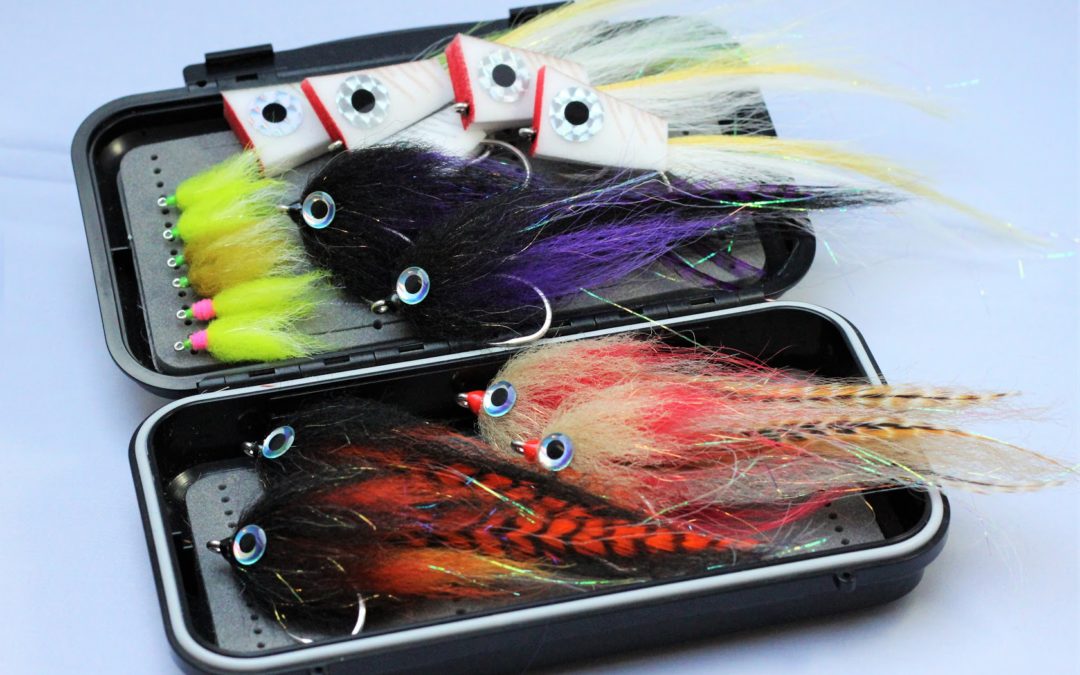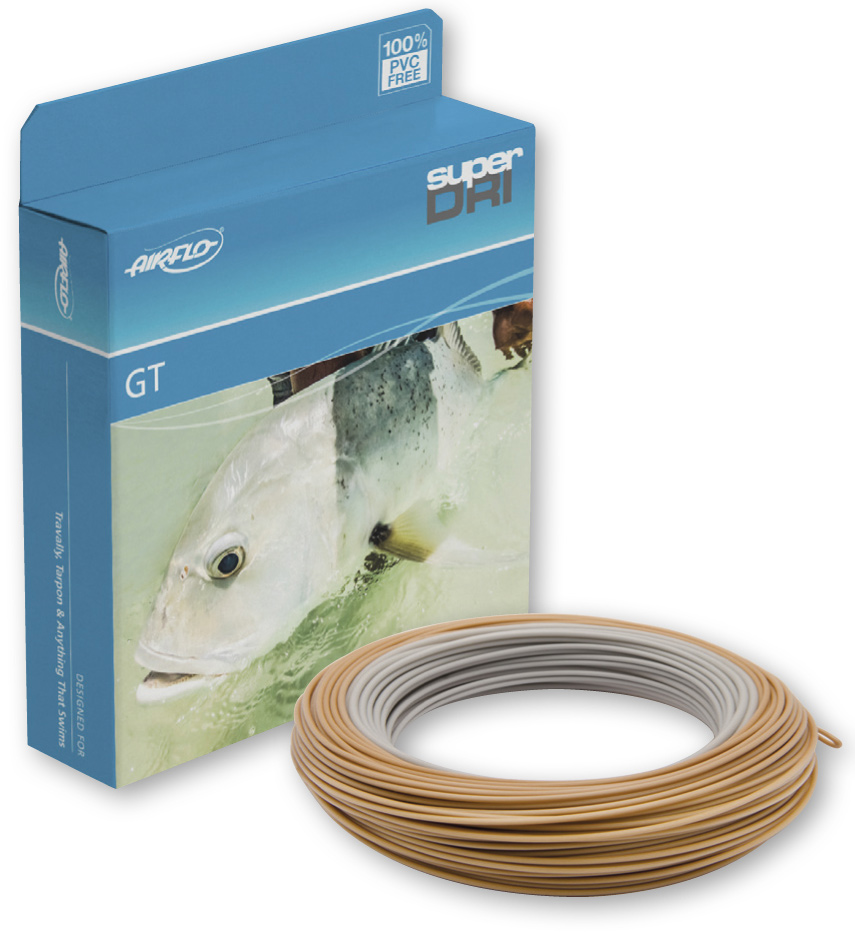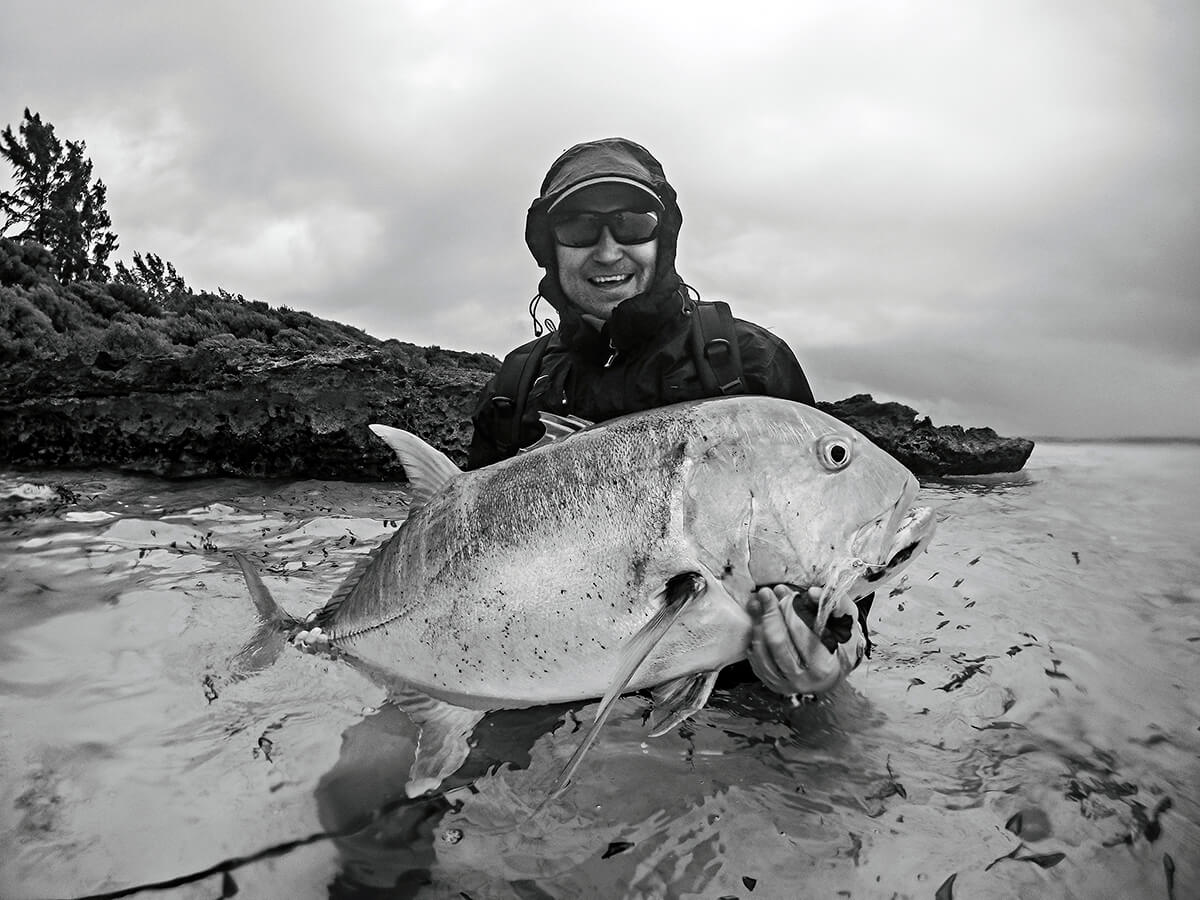By David Radcliffe
Photos by Shawn Wampach (From Tail Fly Fishing Magazine #18)
Don’t get me wrong, I love fishing for bonefish
as much as the next angler.
I just feel a little bit like – been there and done that.
In other words, I’ve spoiled myself.
So a while back I decided that my next trip would focus on Giant Trevally (GT). For this trip, I chose to go to Christmas Island in the Republic of Kiribati, one of the best places to find my quarry, the other being the Indian Ocean. Being from the Arctic, as I am, either location was a long trip, but Christmas Island won out; I have done two DIY trips there in the past and have a degree of familiarity with the fishery. Christmas Island is located in the mid-Pacific Ocean, about halfway between Hawaii and the country of Fiji. The island is serviced weekly by Fiji Airlines out of Honolulu with a modern 737 jet aircraft. The flight, which is a little over three hours, arrives the day after you leave due to the proximity to the dateline. The island is 90 miles north of the equator, meaning that the weather remains constant year-round. If you’re not finding the huge GT, or if you tire from catching GT in the lightweight class, there are many other species here to get your rod bent: tuna to 125 pounds; bonefish to rival the big fish in the Bahamas (up to 12 pounds); and bluefin trevally and triggerfish are also common. All are a ball to get on the end of a fly line. But this being my third DIY trip to the island, I was focused on big GT. Only having one week this trip, I was even more focused than usual. GT are what most people consider the bullies of the reef. They will eat anything they can fit into their mouths – which is a lot. They are a very aggressive fish but shots at GT most often occur when stalking the flats with bonefish gear. They move in fast but move on just as quickly, so usually making a cast with a 12-weight a one-shot deal.

On this trip, because bonefish were second fiddle, I cradled my 12-weight from sunup to sunset. GT are numerous on Christmas Island, but getting one to take a fly, and especially one over 50 pounds, is not so common. My strategy was to patrol likely places where GT would cruise, meanwhile standing on the boat’s bow, my guide poling at the stern. This in itself was a feat, as standing on the bow of what is basically a large canoe is not as easy as it sounds. And falling into water infested with huge schools of barracuda and sharks was not appealing at the time, nor is it appealing when I think back on it now. We often saw schools of barracuda numbering in the hundreds. It seemed that even fish in the large schools would measure four feet. I hooked one barracuda on a fly, and although the fight did not last long, it was an interesting change from scanning the shallows for cruising GT. GT like to travel in packs, like wild dogs, when under around the 40-pound mark. The truly big GT, the ones that get well over 50 pounds, travel alone or in pairs. They are often seen hunting in the company of sharks. Anything that hangs around with sharks is not to be taken lightly. GT fight dirty, making long hard runs toward the first available coral. Getting cut off while using 100-pound leader material is commonplace, as is breaking 12-weights (as I can attest to from my first trip to Christmas Island). On day one I landed five GT up to around 40 pounds. Day two, three more GT along with a brief encounter with a huge barracuda and 20-odd bonefish. On the third day, we got into what was the perfect scenario, a cruising GT, well over 70 pounds, and had lots of time to get into position. A well-placed cast with a five-inch silver mullet fly, a quick strip, and bang, fish on. My Ross reel drag was pre-set to about 12 pounds. This seemed to be of no concern whatsoever to this GT. Line left the reel at the rate of about that of hooking a speeding Volkswagen. I took the liberty of cranking down hard on the drag as far as I dared and the line just kept running toward Fiji, 2,000 miles south. This lasted about five minutes before the GT, or small submarine took me deep into the coral and out the other side. It promptly broke my 120-pound tippet. My guide Michael suggested that this car, or GT, was likely about 80-100 pounds. It was obvious that I needed a different strategy.

On day four I tied six feet of 200-pound mono directly to my Airflo GT line and stalking we went. GT prefer the outgoing tide when they’re inside the vast lagoon. They cruise on current lines, deep channels and drop-offs around flats searching out their next meal. We landed several GT in the teens and a few in the mid-30s, but no real big fish were seen until we were eating our simple lunch of tuna sandwiches and Cokes. We saw him a long way off, slowly and single-mindedly cruising just at the edge of the flat. Lunch was hastily tossed to the coconut crabs and the 12-weight was readied with a big mullet fly. A few quick false casts to get some line in the air and the fly was ungracefully dropped 10 feet in front of the fish. A couple really quick strips and he was all over it. It is important to set the hook good and hard on these fish and to try to turn them from the dark side as quickly as possible. I was using my Sea Level reel this time and the drag was well and cranked down. I finally saw the handle, and not just a black blur, after about 200 yards into the first run. Then he went deep. Having lost the last Volkswagen this way, I tried to put as much pressure on this fish as I felt was possible without blowing up any gear. After what seemed like an hour, my arms were giving out but the fish was coming closer to being at hand. After another run, another turn, and with my arms like wet noodles, the fish was ready to give in.
This is when GT turn into crying little bullies that have been put into their place. As soon as they are tailed and a hand is under the belly, they go into this defeated mode. My fish, and I know it’s a fish at this point and not a car, was right around 80 pounds according to Michael, who has seen lots of fish this size, and bigger. The following day, it was all I could do to cast a rod. My arms were spent, beaten down, in a word, defeated. This was what I had come to do, to catch really big game fish in a pristine environment with an incredible guide and friend on an exotic DIY vacation. All of my trips are DIY, as it allows far more flexibility, allows me to fish for what I want, for as long as I want and with who I want. This trip was no different and I had done what I had come to do, catch a monster GT. Who knows what’s next…?
About the author:
David Radcliffe is a retired teacher who lives in Canada’s Northwest Territories with his wife and two dogs. As you can tell, he’s a fan of DIY fishing and travel, and he can help you arrange your own exotic DIY excursions. David has trips to Scotland, New Brunswick, Uruguay, and Florida planned for the not-so-distant future. Reach him at davidradcliffe@northwestel.net.



